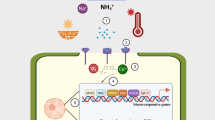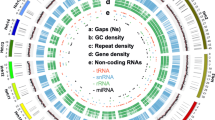Abstract
Piriformospora indica, a root endophytic fungus identified in the Indian Thar desert, colonizes the roots of plants and provides resistance towards biotic stress as well as tolerance to abiotic stress in the plants. Despite its positive impact on the host, little is known about the P. indica genes that are involved in salt stress tolerance. Therefore this study was conducted to identify and isolate high salinity-tolerance genes from P. indica. Thirty-six salinity-tolerance genes were obtained by functional screening, based on random over expression of a P. indica cDNA library in Escherichia coli grown on medium supplemented with 0.6 M NaCl. The salinity tolerance conferred by these 36 genes in bacteria was further confirmed by using another strain of E. coli (DH5α) transformants. However when the expression of these 36 genes was analysed in P. indica using quantitative RT-PCR, we found only six genes were up-regulated by salt stress. These six genes are involved in different cellular processes, such as metabolism, energy and biosynthetic processes, DNA repair, regulation of protein turnover, transport and salt stress tolerance. This work presents the basis for further molecular analyses of the mechanisms of salt tolerance in P. indica and for the use of this endophyte to confer salt tolerance to plants.



Similar content being viewed by others
References
Bonfante P, Genre A (2010) Mechanisms underlying beneficial plant-fungus interactions in mycorrhizal symbiosis. Nat Commun 1:48. doi:10.1038/ncomms1046
Breuninger M, Requena N (2004) Recognition events in AM symbiosis: analysis of fungal gene expression at the early appressorium stage. Fungal Genet Biol 41:794–804. doi:10.1016/j.fgb.2004.04.002
Bücking H, Heyser W (2003) Uptake and transfer of nutrients in ectomycorrhizal associations: interactions between photosynthesis and phosphate nutrition. Mycorrhiza 13:59–68. doi:10.1007/s00572-002-0196-3
Doukhanina EV, Chen S, Van Der Zalm E, Godzik A, Reed J, Dickman MB (2006) Identification and functional characterization of the BAG protein family in Arabidopsis thaliana. J Biol Chem 281:18793–18801. doi:10.1074/jbc.M511794200
Forment J, Naranjo MA, Roldan M, Serrano R, Vicente O (2002) Expression of Arabidopsis SR-like splicing proteins confers salt tolerance to yeast and transgenic plants. Plant J 30:511–519
Harrison MJ (1999) Molecular and cellular aspects of the arbuscular mycorrhizal symbiosis. Annu Rev Plant Physiol Plant Mol Biol 50:361–389. doi:10.1146/annurev.arplant.50.1.361
Harrison MJ, Dewbre GR, Liu J (2002) A phosphate transporter from Medicago truncatula involved in the acquisition of phosphate released by arbuscular mycorrhizal fungi. Plant Cell 14:2413–2429. doi:10.1105/tpc.004861
Hill TW, Käfer E (2001) Improved protocols for aspergillus medium: trace elements and minimum medium salt stock solutions. Fungal Genet Newsl 48:20–21
Jogawat A, Saha S, Bakshi M, Dayaman V, Kumar M, Dua M, Varma A, Oelmüller R, Tuteja N, Johri AK (2013) Piriformospora indica rescues growth diminution of rice seedlings during high salt stress. Plant Signal Behav 8:e26891. doi:10.4161/psb.26891
Joseph JD, Heitman J, Means AR (1999) Molecular cloning and characterization of Aspergillus nidulans cyclophilin B. Fungal Genet Biol 27(1):55–66. doi:10.1006/fgbi.1999.1131
Joshi A, Dang HQ, Vaid N, Tuteja N (2009) Isolation of high salinity stress tolerant genes from Pisum sativum by random overexpression in Escherichia coli and their functional validation. Plant Signal Behav 4:400–412. doi:10.4161/psb.4.5.8387
Kanhonou R, Serrano R, Palau RR (2001) A catalytic subunit of the sugar beet protein kinase CK2 is induced by salt stress and increases NaCl tolerance in Saccharomyces cerevisiae. Plant Mol Biol 47:571–579
Karandashov V, Nagy R, Wegmuller S, Amrhein N, Bucher M (2004) Evolutionary conservation of a phosphate transporter in the arbuscular mycorrhizal symbiosis. Proc Natl Acad Sci USA 101:6285–6290. doi:10.1073/pnas.0306074101
Kizawa H, Tomura D, Odat M, Fukamizu A, Hoshino T, Gotohll O, Yasui T, Shoun H (1991) Nucleotide sequence of the unique nitrate/nitrite-inducible cytochrome P-450 cDNA from Fusarium oxysporum. J Biol Chem 266:10632–10637
Kumar M, Yadav V, Tuteja N, Johri AK (2009) Antioxidant enzyme activities in maize plants colonized with Piriformospora indica. Microbiology 155:780–790. doi:10.1099/mic.0.019869-0
Li W, Liu X, Qiao H, Sun J, Duan D (2005) Two phase tillage: quick method for crop production in saline soils. Agrifood Res Rep 68:66–72
Limpens E, Bisseling T (2003) Signaling in symbiosis. Curr Opin Plant Biol 6:343–350. doi:10.1016/S1369-5266(03)00068-2
Maas E, Bisswanger H (1990) Localization of the alpha-oxoacid dehydrogenase multienzyme complexes within the mitochondrion. FEBS Lett 17:189–190. doi:10.1016/0014-5793(90)80840-F
Mahajan S, Tuteja N (2005) Cold, salinity and drought stresses: an overview. Arch Biochem Biophys 444:139–158. doi:10.1016/j.abb.2005.10.018
Marx J (2004) The roots of plant-microbe collaborations. Science 304:234–236. doi:10.1126/science.304.5668.234
Matouschek A, Rospert S, Schmid K, Glick BS, Schatz G (1995) Cyclophilin catalyzes protein folding in yeast mitochondria. Proc Natl Acad Sci USA 92:6319–6323. doi:10.4161/psb.22734
Mundree SG, Whittaker A, Thomson JA, Farrant JM (2000) An aldose reductase homolog from the resurrection plant Xerophyta viscosa. Planta 211:693–700
Nakashima S, Zhao Y, Nozawa Y (1996) Molecular cloning of delta 9 fatty acid desaturase from the protozoan Tetrahymena thermophila and its mRNA expression during thermal membrane adaptation. J Biochem 317:29–34. doi:10.1016/S1567-1356(02)00088-0
Newman EI, Reddell P (1987) The distribution of mycorrhizas among families of vascular plants. New Phytol 106:745–751. doi:10.1111/j.1469-8137.1987.tb00175.x
Nikolaou E, Agrafioti I, Stumpf M, Quinn J, Stansfield I, Brown AJ (2009) Phylogenetic diversity of stress signalling pathways in fungi. BMC Evol Biol 9:44. doi:10.1186/1471-2148-9-44
Nomura M (1999) Regulation of ribosome biosynthesis in Escherichia coli and Saccharomyces cerevisiae: diversity and common principles. J Bacteriol 181:6857–6864
Parniske M (2004) Molecular genetics of the arbuscular mycorrhizal symbiosis. Curr Opin Plant Biol 7:414–421. doi:10.1016/j.pbi.2004.05.011
Pascale M, Rosati A, Festa M, Basile A, d’Avenia M, Falco A, Torino G, Turco MC (2010) BAG3 protein: role in some neoplastic cell types and Identification as a candidate target for therapy. Apoptosome. doi:10.1007/978-90-481-3415-1_7
Peskan-Berghofer T, Shahollari B, Giong PH, Hehl S, Markert C, Blanke V, Kost G, Varma A, Oelmuller R (2004) Association of Piriformospora indica with Arabidopsis thaliana roots represents a novel system to study beneficial plant-microbe interactions and involves early plant protein modifications in the endoplasmic reticulum and at the plasma membrane. Physiol Plant 122:465–477. doi:10.1111/j.1399-3054.2004.00424.x
Pham GH, Kumari R, Singh AN, Sachdev M, Prasad R, Kaldorf M, Buscot F, Oelmüller R, Peskan T, Weiss M, Hampp R, Varma A (2004) Axenic culture of symbiotic fungus Piriformospora indica. Plant Surf Microbiol. doi:10.1007/978-3-540-74051-3_30
Rausell A, Kanhonou R, Yenush L, Serrano R, Ros R (2003) The translation initiation factor eIF1A is an important determinant in the tolerance to NaCl stress in yeast and plants. Plant J 34:257–267
Selosse MA, Setaro S, Glatard F, Richard F, Urcelay C, Weiss M (2007) Sebacinales are common mycorrhizal associates of Ericaceae. New Phytol 174:864–878. doi:10.1111/j.1469-8137.2007.02064.x
Shannon MC (1997) Adaptation of plants to salinity. Adv Agron 60:75–120
Takayama S, Sato T, Krajewski S, Kochel K, Irie S, Millan JA, Reed JC (1995) Cloning and functional analysis of BAG-1: a novel Bcl-2-binding protein with anti-cell death activity. Cell 80:279–284. doi:10.1016/0092-8674(95)90410-7
Varma A, Savita V, Sudha Sahay N, Butehorn B, Franken P (1999) Piriformospora indica, a cultivable plant-growth-promoting root endophyte. Appl Environ Microbiol 65:2741–2744. doi:10.1128/AEM.05225-11
Viaud MC, Balhadere PV, Talbot NJ (2002) A Magnaporthe grisea cyclophilin acts as a virulence determinant during plant infection. Plant Cell 14:917–930. doi:10.1105/tpc.010389
Waller F, Achatz B, Baltruschat H, Fodor J, Becker K, Fischer M, Heier T, Huckelhoven R, Neumann C, von Wettstein D, Franken P, Kogel KH (2005) The endophytic fungus Piriformospora indica reprograms barley to salt-stress tolerance, disease resistance, and higher yield. Proc Natl Acad Sci USA 102:13386–13391. doi:10.1073/pnas.0504423102
Wang P, Cardenas ME, Cox GM, Perfect JR, Heitman J (2001) Two cyclophilin A homologs with shared and distinct functions important for growth and virulence of Cryptococcus neoformans. EMBO Rep 2:511–518. doi:10.1093/embo-reports/kve109
Weiss M, Selosse MA, Rexer KH, Urban A, Oberwinkler F (2004) Sebacinales: a hitherto overlooked cosm of heterobasidiomycetes with a broad mycorrhizal potential. Mycol Res 108:1003–1010. doi:10.1111/j.1469-8137.1967.tb05434.x
Yadav V, Kumar M, Kumar H, Deep DK, Tripathi T, Sharma R, Tuteja N, Saxena AK, Johri AK (2010) A phosphate transporter from root endophytic fungus Piriformospora indica plays a role in the phosphate transport to the host plant. J Biol Chem 285:26532–26544. doi:10.1074/jbc.M110.111021
Yamada A, Saitoh T, Mimura T, Ozeki Y (2002) Expression of mangrove allene oxide cyclise enhances salt tolerance in Escherichia coli, yeast and tobacco cells. Plant Cell Physiol 4:903–910
Yamada A, Tsutsumi K, Tanimoto S, Ozeki Y (2003) Plant RelA/SpoT homolog confers salt tolerance in Escherichia coli and Saccharomyces cerevisiae. Plant Cell Physiol 44:3–9
Zuccaro A, Lahrmann U, Güldener U, Langen G, Pfiffi S, Biedenkopf D, Wong P, Samans B, Grimm C, Basiewicz M, Murat C, Martin F, Kogel KH (2011) Endophytic life strategies decoded by genome and transcriptome analyses of the mutualistic root symbiont Piriformospora indica. PLoS Pathog 7:e1002290. doi:10.1371/journal.ppat.1002290
Acknowledgments
AJ, PS, VD, SS, SR and MK are thankful to the University Grants Commission, Council of Scientific and Industrial Research and Indian Council of Medical Research, Govt. of India, New Delhi, India respectively for providing the fellowships. AKJ and MD are thankful to the Jawaharlal Nehru University, New Delhi, India for providing University potential of excellence (UPOE) fund.
Conflict of interest
We have no conflict of interest.
Author information
Authors and Affiliations
Corresponding authors
Additional information
Sunayna Gahlot and Amita Joshi have contributed equally to this work.
Electronic supplementary material
Below is the link to the electronic supplementary material.
Rights and permissions
About this article
Cite this article
Gahlot, S., Joshi, A., Singh, P. et al. Isolation of genes conferring salt tolerance from Piriformospora indica by random overexpression in Escherichia coli . World J Microbiol Biotechnol 31, 1195–1209 (2015). https://doi.org/10.1007/s11274-015-1867-5
Received:
Accepted:
Published:
Issue Date:
DOI: https://doi.org/10.1007/s11274-015-1867-5




